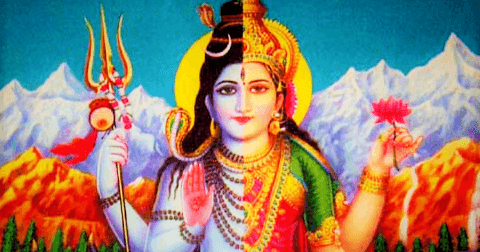
Ardhanarishvara is a composite androgynous form of the Hindu deities Shiva and Parvati (or Shakti). The name “Ardhanarishvara” is derived from three Sanskrit words: “Ardha,” meaning “half,” “Nari,” meaning “woman,” and “Ishvara,” meaning “Lord” or “God.” Therefore, Ardhanarishvara represents the Lord who is half-woman.
Key features and symbolism associated with Ardhanarishvara include:
- Representation of Unity: Ardhanarishvara symbolizes the unity and inseparability of the male and female aspects of the divine. It represents the idea that Shiva and Shakti are not separate entities but are two halves of a single, unified whole.
- Physical Characteristics: The right half of Ardhanarishvara is typically depicted as Shiva, with matted hair, a third eye on the forehead, and a serpent around the neck. The left half is Parvati, adorned with jewelry, and often holding a lotus. The gender-specific attributes of each half are blended seamlessly.
- Symbolic Elements: Ardhanarishvara may be shown with various symbolic elements, such as a crescent moon on Shiva’s head, the Ganges River flowing from Shiva’s hair, and a trident (trishula) in one of Shiva’s hands. Parvati’s hand may hold a mirror or a flower.
- Yin-Yang Symbolism: The imagery of Ardhanarishvara is often likened to the concept of Yin and Yang in Eastern philosophy, signifying the balance and interdependence of opposites.
- Spiritual Significance: Ardhanarishvara embodies the concept of Ardha-Nariswara, emphasizing the idea that the masculine and feminine energies are complementary and necessary for the creation and sustenance of the universe. It is a powerful representation of the unity underlying the apparent duality in the cosmos.
- Cosmic Dance: Ardhanarishvara is sometimes depicted in a dancing pose, highlighting the dynamic and rhythmic nature of the cosmos.
Ardhanarishvara is worshipped as a symbol of divine harmony, balance, and the interdependence of the male and female principles. Devotees seek blessings for marital bliss, understanding, and spiritual realization through the worship of Ardhanarishvara. Temples dedicated to Ardhanarishvara can be found in various parts of India.
